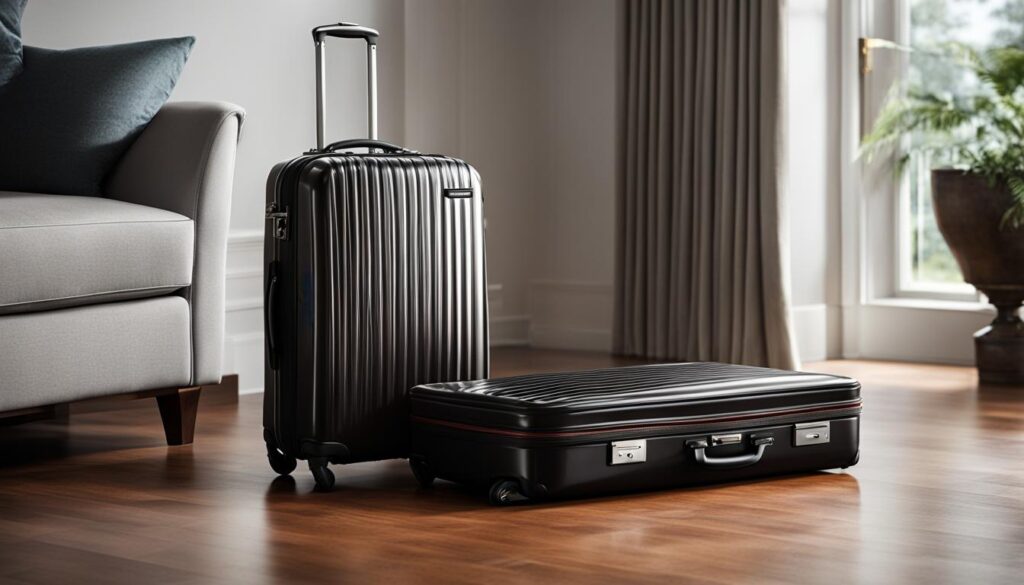When it comes to airport security, there are often questions about what items need to be removed from your bags for screening. One common concern is whether chargers and cables need to be taken out. In this article, I will provide you with the information you need to know about airport security rules regarding chargers.
Key Takeaways:
- Chargers and cables generally do not need to be removed from your carry-on bag for airport security.
- Chargers with built-in rechargeable batteries, like power banks, may need to be taken out and placed in a separate bin for scanning.
- It’s always a good idea to check the specific rules and regulations of the airport you are traveling through to ensure a smooth security screening experience.
- TSA agents prioritize passenger safety and may use their discretion to determine which devices require additional testing.
- By following the guidelines and cooperating with TSA agents, you can help ensure the security and safety of everyone during air travel.
TSA Security Screening of Chargers & Cables
When it comes to airport security, there is often confusion about what items need to be removed from your bag for screening. In the case of chargers and cables, the Transportation Security Administration (TSA) has specific rules that travelers should be aware of.
According to TSA guidelines, chargers and cables can remain in your carry-on bag during the screening process. This means that adapters, phone chargers, and other charging accessories can stay in your bag without the need for removal. However, it’s important to note that larger electronic devices, such as laptops, do need to be taken out and placed in a separate bin. Laptop chargers and cables, on the other hand, can remain in your bag.
It’s worth mentioning that these rules may vary slightly depending on the airport and the scanning technology used. It’s always a good idea to check the specific rules and regulations of the airport you are traveling through to ensure a smooth security screening experience. By familiarizing yourself with the guidelines and cooperating with TSA agents, you can help make the process more efficient for everyone involved.
| Item | Screening Process |
|---|---|
| Chargers and cables | Can remain in carry-on bag |
| Laptops | Need to be removed from bag and placed in separate bin |
| Laptop chargers and cables | Can remain in carry-on bag |
By understanding the TSA’s rules regarding chargers and cables, you can confidently pack your electronic accessories without any unnecessary hassle at the security checkpoint. Remember to always double-check the regulations of the airport you are traveling through to ensure a seamless journey. Safe travels!
What Do You Need To Put In A Separate Bin At The Security Screening Checkpoint?
While chargers and cables do not have to be placed in a separate bin, there are other items that may need to be removed from your bag and placed in their own bin. These include any personal electronic devices larger than a cell phone, such as laptops, tablets, and game consoles. Additionally, items like e-readers, larger cameras, and quart-size liquids toiletry bags may also need to be separated for screening. It is important to note that multiple items can be placed in one bin, but they should not be piled on top of each other to ensure clear X-ray screening.
Table: Items to be placed in a separate bin at the security screening checkpoint
| Item | Reason for Separation |
|---|---|
| Personal electronic devices larger than a cell phone (e.g., laptops, tablets, game consoles) | Clear X-ray screening |
| E-readers | Clear X-ray screening |
| Larger cameras | Clear X-ray screening |
| Quart-size liquids toiletry bags | Compliance with liquid restrictions |
It is important to follow these guidelines to ensure a smooth security screening process. By separating these items, you help TSA agents accurately identify and inspect them, ensuring the safety and security of all passengers. Remember to place these items in a separate bin and avoid stacking them on top of each other, allowing for clear X-ray screening.
Why Do You Need to Take Out Chargers for Airport Security?
When going through airport security, you may wonder why chargers need to be taken out of your bag for screening. While regular chargers without built-in batteries can typically remain in your carry-on, there are a few reasons why some chargers require special handling.
One of the main reasons is that chargers with built-in rechargeable batteries, like power banks, need to be inspected separately. These types of chargers contain larger batteries that can be potential safety hazards if not properly screened. By removing them from your bag and placing them in a separate bin, TSA agents can easily identify and examine them without causing any delays.
Another reason for taking out chargers is to avoid interference with the X-ray scanner images. If you have a large quantity of chargers in your bag, they can create a cluttered image that may make it difficult for the agents to identify other items in your bag accurately. Separating the chargers for screening ensures a clear and accurate X-ray image, making the process more efficient.
It’s important to note that these rules and guidelines may vary slightly depending on the airport and the specific scanning technology used. To ensure a smooth and hassle-free security screening experience, always check the rules and regulations of the airport you are traveling through before heading to the airport.
How Do TSA Agents Test Electronic Devices at Airport Security?
When it comes to airport security, TSA agents have a systematic approach to screening electronic devices. Their goal is to prioritize passenger safety while ensuring efficient processes. Let’s take a closer look at how TSA agents decide which devices to test and how they carry out the testing.
The Screening Process
During the security screening process, TSA agents use advanced scanning equipment, including X-ray scanners, to inspect electronic devices and luggage. Devices containing batteries, such as laptops, tablets, and phones, are typically removed from the bag and placed in a separate bin for scanning. The X-ray scanners provide a clear image of the device and its internal components.
Types of Testing
TSA agents rely on their expertise and discretion to determine which devices require additional testing. While most devices go through standard screening procedures, devices with built-in rechargeable batteries may be subject to closer inspection. Agents may perform swab tests to detect any explosive residue on the device, ensuring the safety of all passengers.
Expedited Screening with TSA Precheck
If you want to expedite the security screening process and avoid thorough examinations, you can apply for TSA Precheck. This program allows pre-approved passengers to enjoy a faster and more streamlined screening experience. With TSA Precheck, you can keep your shoes, jackets, and belts on, and leave your electronic devices inside your bag, making the process more convenient and efficient.
By understanding how TSA agents test electronic devices, you can be prepared for airport security procedures. Remember to follow all TSA guidelines and cooperate with the agents to ensure a smooth and secure journey.

Conclusion
In conclusion, when it comes to airport security screening, you do not need to take out most chargers and cables from your carry-on bag. Phone chargers, laptop chargers, and other regular charging cables can remain in your bag during the process. However, chargers with built-in rechargeable batteries, like power banks, should be taken out and placed in a separate bin for scanning.
It’s important to note that each airport may have its own set of rules and regulations, so it’s always a good idea to check before you travel. By familiarizing yourself with the specific guidelines of the airport you are passing through, you can ensure a smooth and hassle-free security screening experience.
Remember, the primary goal of airport security is to ensure the safety and security of all passengers. By cooperating with TSA agents and following the guidelines, you contribute to the overall efficiency and effectiveness of the screening process. So, pack your chargers and cables confidently, knowing that you can navigate airport security with ease.
FAQ
Do I need to take out chargers for airport security?
Chargers and cables, such as phone chargers and laptop chargers, typically do not need to be removed from your carry-on bag during the airport security screening process. However, chargers with built-in rechargeable batteries, like power banks, should be taken out and placed in a separate bin for scanning. Always check the specific rules of the airport you are traveling through for any variations.
What items need to be put in a separate bin at the security screening checkpoint?
Personal electronic devices larger than a cell phone, such as laptops, tablets, and game consoles, need to be removed from your bag and placed in a separate bin. Additionally, items like e-readers, larger cameras, and quart-size liquids toiletry bags may also need to be separated for screening. Remember, multiple items can be placed in one bin, but they should not be piled on top of each other to ensure clear X-ray screening.
Why do chargers sometimes need to be taken out for airport security?
Regular chargers without built-in batteries usually do not need to be removed. However, chargers with built-in rechargeable batteries, such as power banks, need to be taken out and placed in a separate bin for scanning. This is to allow for proper inspection, especially if you are carrying a large quantity of chargers, which may interfere with the X-ray scanner images.
How do TSA agents decide which devices to test and how do they test them?
TSA agents use advanced scanning equipment, including X-ray scanners, to inspect electronic devices and luggage. Devices containing batteries, like laptops, tablets, and phones, are typically removed from the bag and placed in a separate bin. The agents prioritize passenger safety and may choose to conduct additional testing on devices with built-in rechargeable batteries. Applying for TSA Precheck can help expedite the security screening process and minimize thorough examinations.
Do these guidelines apply to all airports?
While these guidelines generally apply across most airports, it’s essential to check the specific rules and regulations of the airport you are traveling through. Different airports may have slight variations depending on their security procedures and scanning technology.




